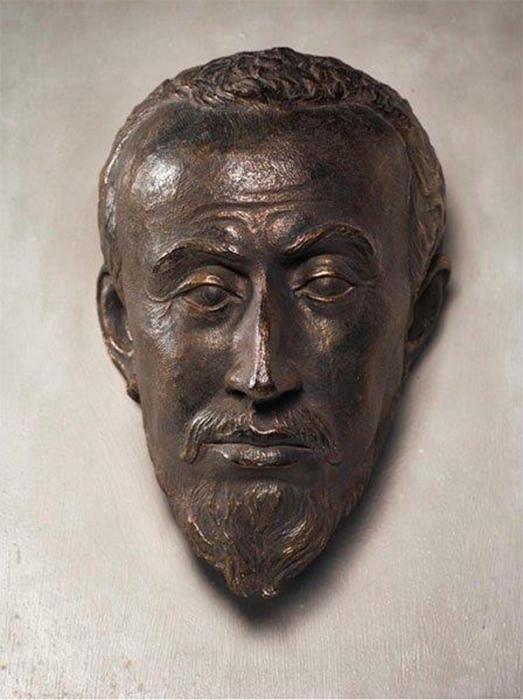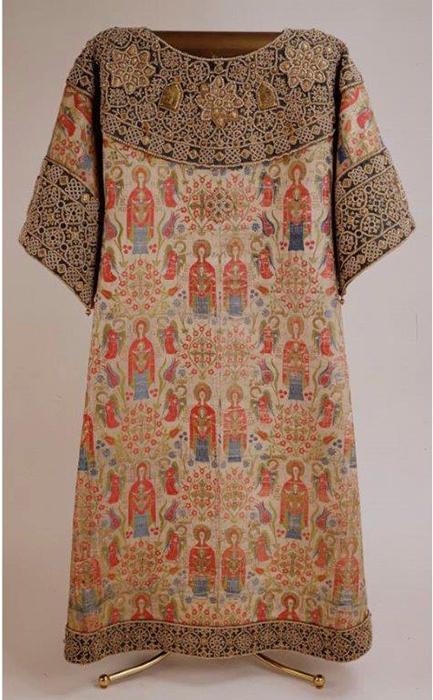On 31 May 1584, in the Assumption Cathedral of the Moscow Kremlin, there was held the coronation of Tsar Fyodor Ioannovich – the last representative of the Rurikid dynasty. It was the first ceremony held in full accordance with the order of coronation of Byzantine emperors. For the first time, the son of the first Russian tsar was anointed. The main part of the complex ceremony was the “grand” entry. The tsar with retinue went solemnly to the Assumption Cathedral of the Moscow Kremlin. Inside the cathedral, there was prepared a special tsar place, where the metropolitan laid the crown on the tsar’s head. Metropolitan Dionysius handed the sceptre to the tsar, which became a meaningful addition to the ceremony. The words, that followed the handover, uncover the symbolic meaning of this item. The sceptre was handed over in the right hand of the sovereign with the words: “with the given sceptre to govern the gonfalons of the Great Russian Tsardom”. In the Old Rus, the holy banners were called the gonfalons. Under these banners, the Christ invisibly leads the pious orthodox host. Being God’s vicar on Earth, tsar alike the Christ leads the dependent people the way. Thus, the sceptre became a real symbol of power that the tsar accumulated in his hands. During receptions in the palace, the tsar held it in the right hand, and during grand outings, it was carried before the tsar by special court officials.
There has survived a picturesque description of Tsar Fyodor Ioannovich’s coronation ceremony, witnessed by English diplomat, Sir Jerome Horsey. This how he describes the beginning of the ritual: “The tsar left the palace, the metropolitan went ahead with archbishops, bishops, principle figures of the monkhood and secular clergy in rich caps and vestments. They carried icons of the Virgin and the others, icon of Tsar’s Holy Angel, gonfalons, and many other items appropriate for the ceremony, and sang all the time”. Then, there comes a description of what was happening in the cathedral, when the tsar entered it. “His robes were put off and substituted by the most precious and worthless attire. The tsar was led to the tsar’s place, his retinue stood around according to the ranks, the metropolitan laid the crown on the monarch’s head … All six crowns – symbols of power overnation lands - were placed before the tsar.. Afterwards, the metropolitan started reading out loud a small book – the admonitions for the tsar to administer true justice, peacefully possess the crown of his ancestors, given to him by God as a gift…”
When the main part of the ceremony finished, the tsar’s solemn procession moved out off the cathedral: “Then, the tsar was taken down from the tsar’s place, he was wearing precious upper garments decorated with different stones and numerous Oriental pearls of high value. It weighed 200 pounds, six princes carried its train and laps. His principal valueless tsar crown was on his head, in the right hand he had a tsar staff, three and a half feet long, made of unicorn bone and decorated with precious stones…”. When the tsar and his followers entered the Faceted Chamber, the royal banquet began. “After a short speech, the tsar let everyone kiss his hand, which was done, and then he passed to his royal place at the table, where his noblemen served him with all honours. The first three rooms, large and spacious, were piled with dishes of gold and silver from the floor to the ceiling, one above the other…”. But the banquet was not the end of the feast. “The celebrations continued for the whole week, during which different royal entertainment took place”.
When everything was over, “upon the tradition, all noblemen, officials and tradesmen, everyone in his turn, presented to the tsar costly gifts, wishing him long life and happiness during the rule”. In his turn, the tsar awarded many of his loyalists. Particularly generous was the tsar to the brother of his wife – Boris Fyodorovich Godunov, who became an actual head of state during the rule of Fyodor Ioannovich.

Parsuna(portrait) of Tsar Fyodor Ioannovich
(Copy of the 17th-čüentury painted portrait) Russia, Moscow. Wood, gesso, egg tempera.
The image of Fyodor Ioannovich entered a group of early painted portraits (parsuna) that were made in tempera technique on boards and then placed by the tombs of the grand princes and tsars in the Archangel Cathedral. These images were added to the wall-painting in the cathedral-shrine of the Moscow ruling dynasty: the lower tier of the frescoes placed the images not only of grand, but also of appanage princes of the Rurikids. “Parental tombs” in the Archangel Cathedral had a significant meaning in the court ceremonial. In the 14th-15th centuries, when an agreement was concluded, the ritual of “cross kissing” took place by the tombs of the ancestors. Visiting of the predecessors’ shrines had become an obligatory part of the ceremonies connected with the enthronement of Russian sovereigns.

Sculptural portrait of Tsar Fyodor Ioannovich
Reconstruction by ą£.ą£. Gerasimov. 1964.
In 1963, the tomb of Fyodor Ioannovich which was located in the diaconicon and side chapel of St John the Forerunner in the Archangel Cathedral of the Moscow Kremlin was opened for archaeological research. Famous anthropologist M.M. Gerasimov reconstructed the visage of Tsar Fyodor Ioannovich according to the remains preserved in the sarcophagus.

Regalia Collar (Barmy) of Tsar Fyodor Ioannovich
Satin, damask – Italy, 16th c., needlework – Moscow, late 16th čü. Damask, satin, silver-gilt thread, weaving, needlework.
Ancient barmy, preserved in the Armoury Chamber collection, must have been made in the 16th century for the son of Tsar Ivan the Terrible, Tsar Fyodor Ioannovich. The regalia collar was made of Italian blue damask and embroidered with silk and golden threads. The embroidered images of Jesus Christ, the Virgin, St John the Baptist, archangels and patron saints of the royal family, including St Theodore Stratelates, namesake saint of Tsar Fyodor Ioannovich, are placed on the stylized floral background of the collar.

Sakkos of Metropolitan Dionysius
Moscow, 1583; brocaded satin - Turkey, 1570s.; damask – Italy, second half of the 16th čü. Brocaded satin, satin, damask, taffeta, gold, silver, pearls; weaving, needlework, niello, enamel, filigree, gilding.
The sakkos comes from the Patriarchs' sacristy. It was restored in 2001 by S.S. Shabelnik.

Kopeck
Moscow, Novgorod, Pskov, Yaroslavl, Tsar Fyodor Ioannovich (1584-1598). The Second Volunteer Army of K. Minin and D. Pozharsky (1612-1613). Silver; chasing, gilding. The Moscow Kremlin Museums.
The image of a horseman with a spear is placed on the face side, and on the backside, there is an inscription in several lines with the name and title of the sovereign. “The showering” had become an important element of the coronation for the princedom, and then – for the tsardom. It was entrusted to “the brother or the closest relative” of the monarch. The ritual was executed three times – when the tsar left the Assumption, Archangel and Annunciation Cathedrals.
Tsar Fyodor Ioannovich had become the first one, in whose ritual another person took part. It was Vasily Arslanovich, Prince of Kasimov. The prince was not the closest relative of the future tsar, he was close to him by title. Prince Vasily was the great-grandson of Kuchum Khan and bore the name Sayed Borhan Khan before his christening in 1653.

Tombstones
Of Tsar Ivan IV Vasilievich the Terrible, Prince Ivan Ivanovich and Tsar Fyodor Ioannovich in the diaconicon of the Archangel Cathedral (from left to right).